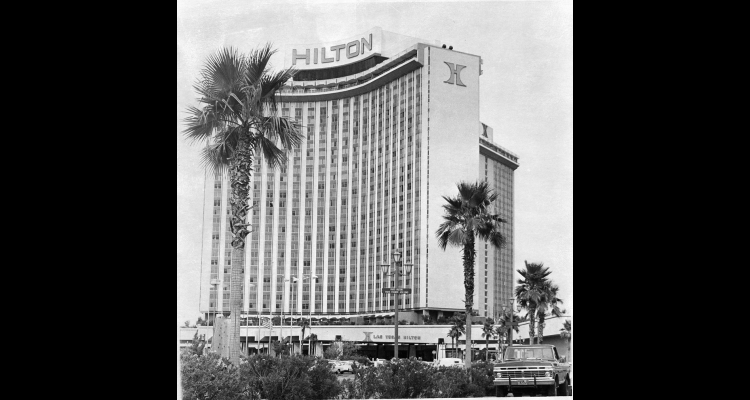International Hotel
The International Hotel, known today as the Westgate Las Vegas Resort & Casino, was the first "megaresort" built in Las Vegas and set new standards for future resorts. The largest hotel and casino in the world when it opened in 1969, it was where pop singer Elvis Presley would perform hundreds of times, and its location beside the Las Vegas Convention Center made it a top hotel for conventioneers.
The visionary behind the International was Kirk Kerkorian. In 1967, he bought sixty-four and a half acres on the east side of Paradise Road between Desert Inn Road and Sahara Avenue, about a half-mile east of the Las Vegas Strip, from developer Martin Kratter. Kratter had wanted to build a 1,500-room resort on the land, but opted to sell the tract to Kerkorian for $5 million.
Kerkorian began planning what would be the world's largest resort on the site. By 1967, Las Vegas was drawing fourteen million visitors a year. Kerkorian believed Las Vegas would continue to need more hotels. He predicted that his resort would spawn a line of resorts and create a new "strip" along Paradise. He hired a business associate, Fred Benninger, to oversee the project. To learn how to operate a resort, Kerkorian decided to acquire the Flamingo on the Strip. Benninger hired away the Sahara Hotel's vice president, Alex Shoofey, to run the Flamingo, and Shoofey brought over staff from the Sahara.
Kerkorian eventually spent $60 million to cover building costs of the International. Before opening the hotel-casino in 1969, Kerkorian received approval from the U.S. government's Securities and Exchange Commission (SEC) to sell shares of stock in his company, International Leisure, to help finance the construction.
When it opened on July 1, 1969, the thirty-story International, with 1,512 rooms, was the world's largest hotel. Its gaming area, at 30,000 square feet, was also the largest casino. With the town's convention center next door, the International was instantly a favored and convenient spot for conventioneers to stay, meet, drink, and eat. The International was the first in Las Vegas to offer a hostel where kids could enjoy swimming, field trips, and other activities while their parents gambled or played. Another innovation, later copied by other megaresorts, was a string of restaurants with specialized cuisines such as Chinese, Japanese, Italian, Mexican, and German. The restaurant area was placed so that people would pass by on their way to and from the convention center.
The opening performer in the hotel's Showroom Internationale was Barbra Streisand, followed a few weeks later by Presley, the one-time superstar pop singer who chose the venue to stage his career comeback. Elvis' debut at the International was a smash success—his first fifty-eight shows were sellouts. Presley, who stayed at a 5,000-square-foot top-floor International suite named after him, performed in the showroom 837 times, ending in 1976. Originally signed to a contract for $100,000 a week for eight weeks a year, during his first engagement in 1969, Presley became the first entertainer to actually make money in a Las Vegas showroom—his ticket sales at the International surpassed $2 million.
But while visitors flocked to the International, Kerkorian had hefty debts to pay off from creditors in Europe. He asked the SEC to let him sell additional shares of stock to raise funds, but an investigation launched by the agency delayed the sale until it was too late. After the value of shares in his International Leisure had fallen drastically, Kerkorian sold half of his interest in the company—and soon, the rest of it—to Hilton Hotels, which took over the International and Flamingo hotels in 1970.
Under Hilton's ownership, the International was renamed the Las Vegas Hilton, and business got better and better. By the late-1980s, Hilton's hotel-casino holdings in Nevada (the Las Vegas Hilton, Flamingo Hilton, and Reno Hilton) earned forty percent of the revenues of the entire hotel chain. At one point in the 1980s, the Las Vegas Hilton was the highest-grossing convention hotel in the United States.
In the 1990s, the Las Vegas Hilton installed the Superbook, which at 30,000 square feet was for a time Nevada's largest race and sports book, and "Star Trek: The Experience," a thrill ride, museum, casino, bar, and restaurant themed after the Star Trek TV series, and a 70,000 square-foot center for conventions and meetings.
The Hilton's ownership evolved with the hotel. Hilton's gaming properties became part of Ballys-Park Place, which in turn would merge with Caesars and eventually Harrah's Entertainment. Park Place tried to sell the Hilton in 2000 to Los Angeles developer Ed Roski, but the deal fell through and led to lawsuits that both sides settled. In 2003, Park Place agreed to sell the Hilton to an affiliate of Colony Capital, which continued to expand and renovate the property with its partner, Whitehall Street Real Estate Funds.
By the mid-2000s, the Las Vegas Hilton had 3,000 rooms, including luxury suites of 5,000 to 7,000 square feet, two ballrooms, and a skywalk bridge to the Las Vegas Convention Center. It added an $18 million pool and sun deck with private cabanas. The hotel's 1,700-seat (renamed) Hilton Theater, where Elvis once played, featured major performers and was described by the hotel's promoters as "the last remaining great showroom in Las Vegas." In 2012, the Hilton ended its license agreement with the property, and it became the Las Vegas Hotel & Casino.
Article Locations
Related Articles
None at this time.
Further Reading
None at this time.


